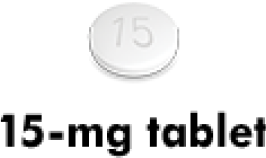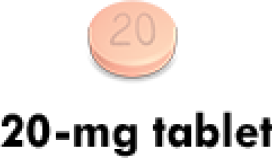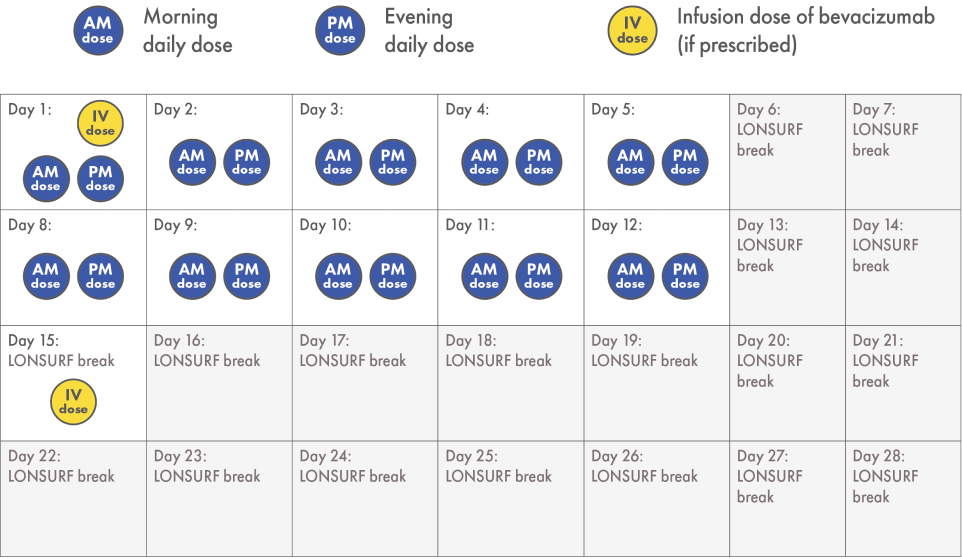How to take LONSURF
Dosing
LONSURF tablets, whether prescribed alone or along with bevacizumab, are swallowed whole (not crushed, split, or chewed):
Twice a day with food
The type of food does not matter
LONSURF comes in 2 strengths: 15-mg and 20-mg tablets

Actual tablet size is 7 mm for 15-mg dose.

Actual tablet size is 8 mm for 20-mg dose.
Tablets shown are not actual size.
LONSURF 28-day dosing schedule
- You will take LONSURF twice a day (with morning and evening meals) for 5 days, and then rest for the next 2 days. This goes on for 2 weeks. Then you will not take LONSURF for 2 weeks (14 days). This completes the 28-day LONSURF treatment cycle
- This is repeated for as long as your healthcare provider says. Always follow all of your healthcare provider's directions carefully
For the majority of patients with colorectal cancer, LONSURF may be prescribed to be used with bevacizumab. Bevacizumab is given as an infusion once every 2 weeks (on days 1 and 15 of your LONSURF treatment cycle) by a doctor or nurse.
Tracking your treatment with LONSURF


Your healthcare provider may prescribe a morning and evening daily dose of LONSURF that requires you to take a combination of 15-mg and 20-mg tablets at the same time.
See more dosage directions
Other things to keep in mind about taking LONSURF
- Make sure your caregiver wears gloves when handling LONSURF
- Note that there is a packet inside the bottle that helps absorb moisture. Do not swallow this material
- Keep LONSURF out of the reach of children
- Store LONSURF at room temperature between 68°F and 77°F (20°C to 25°C)
- Don't store LONSURF with other medicines. Keep LONSURF in its own container
- If you store your tablets outside of the original container, any unused LONSURF tablets should be disposed of after 30 days
- Wash your hands after handling LONSURF. Even though it is a pill, it is still chemotherapy
Contact your healthcare provider if:
- You miss a dose. Do not take additional doses to make up for the missed dose. Call your healthcare provider for instructions about what to do for a missed dose
- You have leftover tablets. Your healthcare provider or pharmacist will tell you how to dispose of them properly
Create your personalized LONSURF treatment calendar
With this simple tool, you can create and print a personalized LONSURF treatment calendar where you can organize your treatment schedule and track your doses, temperature, and any side effects you experience. Make sure to share your calendar with your healthcare provider at your next appointment.
Note: If your doctor changes your LONSURF dosage, be sure to create a new treatment calendar.
Steps for entering your doses into your calendar
During your treatment with LONSURF, your healthcare provider may need to change your treatment plan. These changes are often made to help address certain side effects.
LEARN MOREINDICATIONS
INDICATIONS
LONSURF is a prescription medicine used:
- alone or in combination with the medicine bevacizumab to treat adults with colorectal cancer:
- that has spread to other parts of the body, and
- who have been previously treated with certain chemotherapy medicines
- alone to treat adults with a kind of stomach cancer called gastric cancer including adenocarcinoma of the gastroesophageal junction:
- that has spread to other parts of the body, and
- who have been previously treated with at least 2 types of treatment which included certain medicines
It is not known if LONSURF is safe and effective in children.


INDICATIONS
LONSURF is a prescription medicine used:
- alone or in combination with the medicine bevacizumab to treat adults with colorectal cancer:
- that has spread to other parts of the body, and
- who have been previously treated with certain chemotherapy medicines
- alone to treat adults with a kind of stomach cancer called gastric cancer including adenocarcinoma of the gastroesophageal junction:
- that has spread to other parts of the body, and
- who have been previously treated with at least 2 types of treatment which included certain medicines
It is not known if LONSURF is safe and effective in children.
IMPORTANT SAFETY INFORMATION
LONSURF may cause serious side effects, including:
- Low blood counts. Low blood counts are common with LONSURF and can sometimes be severe and life-threatening. LONSURF can cause a decrease in your white blood cells, red blood cells, and platelets. Low white blood cells can make you more likely to get serious infections that could lead to death. Your healthcare provider should do blood tests before you receive LONSURF, at day 15 during treatment with LONSURF, and as needed to check your blood cell counts. Your healthcare provider may lower your dose of LONSURF or stop LONSURF if you have low white blood cell or platelet counts
Tell your healthcare provider right away if you get any of the following signs and symptoms of infection during treatment with LONSURF: fever, chills, or body aches.
Before taking LONSURF, tell your healthcare provider about all of your medical conditions, including if you:
- Have kidney or liver problems
- Are pregnant or plan to become pregnant. LONSURF can harm your unborn baby
- Females who can become pregnant: Your healthcare provider will do a pregnancy test before you start treatment with LONSURF. You should use effective birth control during and 6 months after the last dose of treatment with LONSURF. Tell your healthcare provider immediately if you become pregnant
- Males, while on treatment and for 3 months after your last dose of LONSURF, you should use a condom during sex with female partners who are able to become pregnant. Tell your healthcare provider right away if your partner becomes pregnant while you are taking LONSURF
- Are breastfeeding or plan to breastfeed. It is not known if LONSURF passes into your breast milk. Do not breastfeed during treatment with LONSURF and for 1 day after your last dose of LONSURF
Tell your healthcare provider about all the prescription and over-the-counter medicines, vitamins, and herbal supplements you take.
The most common side effects of LONSURF when used alone include low blood counts, tiredness and weakness, nausea, decreased appetite, diarrhea, vomiting, stomach-area (abdominal) pain, and fever.
The most common side effects of LONSURF when used in combination with bevacizumab include low blood counts, tiredness and weakness, nausea, certain abnormal liver function blood tests, decreased salt (sodium) in your blood, diarrhea, stomach-area (abdominal) pain, and decreased appetite.
Tell your healthcare provider if you have nausea, vomiting, or diarrhea that is severe or that does not go away.
These are not all of the possible side effects of LONSURF. For more information, ask your healthcare provider. Call your doctor for medical advice about side effects.
You are encouraged to report negative side effects of prescription drugs to the FDA. Visit www.fda.gov/medwatch or call 1-800-FDA-1088.



